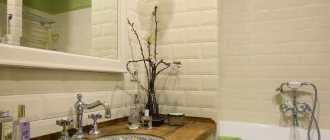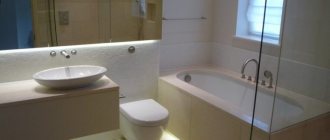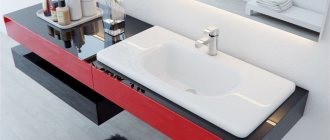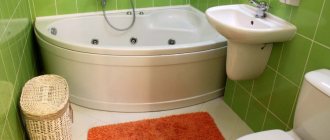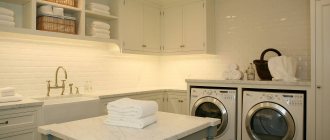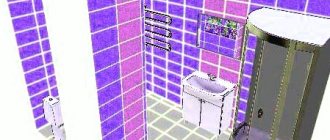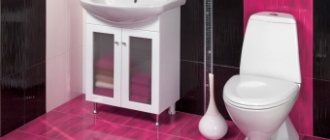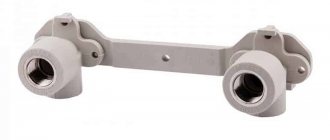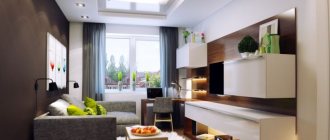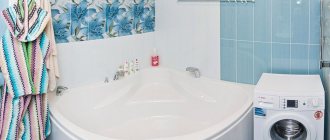Glass wallpaper
There are many myths and superstitions around glass wallpaper, as a relatively new material for us. Some say that all the advantages of this coating are just marketing, but in fact “wallpaper is like wallpaper.” Others argue that glass wallpaper is terribly harmful, like glass wool, and therefore should be excluded from residential premises. Still others, on the contrary, declare that all of Europe only glues glass wallpaper to their walls, since there is nothing better. Where is the truth and where is idle fiction? Let's talk about the pros and cons of glass wallpaper and the features of working with them.
Pros and cons of fiberglass in bathroom interiors
The use of glass wallpaper for the bathroom has both strengths and weaknesses. The feasibility of such a solution depends on the characteristics of the room, the features of the renovation and the available budget.
Material advantages
Strengths of fiberglass wallpaper:
- High strength and wear resistance. The material is able to retain its original properties and appearance for up to 30 years of use, even with regular contact with moisture and temperature changes.
- Strength. Fiberglass is difficult to tear or deform even under direct load. It withstands water or impacts well and does not deteriorate from the claws of pets.
- Fire resistance, fire safety. Glass wallpaper does not burn and prevents the spread of fire throughout the room. Due to this quality, they are used for finishing evacuation routes in schools and hospitals.
- Ecological cleanliness. Only natural materials are used in the production of linen: sand, quartz, dolomite, soda, modified starch. Thanks to this, the material is considered hypoallergenic and safe for health.
- Antistatic. Due to their weave structure, fiberglass wallpaper does not accumulate static electricity.
- Easy to care for. The finish is easily washed from dust and dirt; standard chemicals are allowed for cleaning.
Fiberglass wallpaper has high strength and wear resistance. The advantages of the finish include its unusual appearance and the possibility of repainting. The canvas can be painted up to 30 times without loss of quality and while maintaining the original relief pattern.
Disadvantages of glass wallpaper
The weaknesses of glass wallpaper are the high price and complexity of installation. Finishing walls with them will cost more than using standard non-woven or textile fabric, not only due to the purchase of the roll itself, but because of the wages of workers.
Briefly about the properties of fiberglass
Fiberglass wallpaper is a roll covering that is produced using a weaving method using a special type of glass.
Under the influence of temperature treatment within 1200 ° C, glass briquettes are melted, turning into a liquid mass, and then drawn into yarn.
The material is “knitted” from glass fibers using various weaving techniques, like, for example, a woolen scarf, but the technology of “weaving” such a fabric is much more complex
The fabric created by weaving does not tear or break when stretched, and does not accumulate static stress.
To give the material stable rigidity, it is additionally impregnated with a special composition. Impregnations increase the moisture-repellent properties of the fabric. Thanks to this, glass wallpaper can be used in the bathroom.
Modern glass wallpaper has the trademark “for healthy housing” because it is hypoallergenic and does not accumulate electrical charges.
This coating is indicated for finishing rooms in which maintaining sterile cleanliness is one of the vital criteria.
Video: all about fiberglass wallpaper
Glass wallpaper was first invented in Germany in 1931. They were produced only under one brand name “VITRULAN”.
The material became widespread only in the 60s, when its production technology was adopted by a Swedish company with the participation of the American concern Johns Manville.
Over the years, developers and designers have offered customers many types of fiberglass canvas and wallpaper, as well as fiberglass reinforcing mesh.
By the end of the 20th century, the production of glass wallpaper was already on stream. Today, domestic manufacturers occupy far from the last places in this area.
Advantages of glass wallpaper
Fiberglass wallpaper for painting has a whole range of positive qualities:
Moisture resistance – the material can withstand high humidity without problems, so it’s perfect even for the kitchen and bathroom.
- Durability - fiberglass wallpaper does not tear, crack, scratch or press, allowing it to withstand any operating conditions. They can be repainted up to 20 times and all this time the cladding will retain its attractive appearance.
- Fire resistance - glass wallpaper does not catch fire not only when exposed to high temperatures, but also when in direct contact with fire. Moreover, in such situations they do not even release toxins.
- Antistatic – glass is not prone to electrification, so this wallpaper does not attract lint, dust and wool. That is, they are not scary for allergy sufferers.
- Air permeability - glass wallpaper allows air to pass through unhindered, so the room does not create an uncomfortable feeling of dryness.
- Environmental friendliness - in the manufacturing process of fiberglass wallpaper, exclusively natural components are used, so they are environmentally friendly. In addition, fungi and other parasites that successfully reproduce in other coatings do not coexist in glass wallpaper.
- Easy to maintain - to remove dirt from glass wallpaper, you just need to wash it with water.
What is the material?
When entering any apartment and inspecting the bathroom, you can most often see tiles. This material certainly has many advantages, since such repairs are carried out for a long time. This, on the one hand, is an advantage of the tile, and on the other hand, its disadvantage, since after a couple of years such a coating begins to get boring, and you want to somehow change the interior of the bathroom. There are probably few people willing to rip out the tiles and lay a new version of the tiles in 2-3 years; this is a rather labor-intensive process.
It is much easier to choose glass wallpaper for finishing a bathroom. This material appeared on the market not so long ago. More often it is used to decorate walls in shops and government institutions. This material was developed by German specialists; in our country, fiberglass wallpaper has not yet gained such great popularity.
Such wallpaper is a wall covering that is similar in structure to fiberglass fabrics. During production, all harmful substances are removed from the yarn. This material can be called environmentally friendly, so it can even be suitable for decorating a children's room. Fiberglass canvas can be used in rooms with high humidity, which is why it will be very relevant when decorating a bathroom.
Such environmentally friendly materials are certified and are designated as class “A” wallpaper. It is not for nothing that this material is used in the decoration of restaurants of the McDonalds chain, which is known for its high requirements for environmental safety.
Such glass wallpaper lasts up to 30 years, which allows you to significantly save your budget; all this time you will not need to worry about renovating the room.
Finishing with fiberglass wallpaper will allow you to update the design of the room up to 20 times, each time using new colors for painting.
When making glass wallpaper, the material is treated with a special compound, which adds special rigidity and increases the water-repellent properties of the coating. For additional protection of the coating, special paints and varnishes are used.
The material turns out to be very durable, it cannot be broken, torn, or stretched. In production, only natural substances are used, such as quartz sand, soda, limestone and dolomite. Due to the fact that the composition does not contain a nutrient medium for fungus and mold, they do not appear on the surface covered with glass wallpaper.
The material is additionally impregnated with special agents that protect the surface from the development of microorganisms.
For those who prefer painted surfaces, you can choose glass wallpaper for painting. Since the range of designs is small, it is better to repaint the wallpaper each time in a new color, thereby changing the design of the room.
Qualities and advantages
The technical features of the product and its advantages were determined by professionals and ordinary buyers.
Environmental friendliness
When it comes to high-quality wallpaper, manufacturers use exclusively safe and natural raw materials. Due to this characteristic, the finish can be used to decorate children's rooms, as well as in houses where allergy sufferers live.
Special texture
Fiberglass wallpaper is a breathable material. Due to the air permeability, comfortable conditions are created in the room. Excess moisture, which causes the formation of fungus and bacteria, does not accumulate under and on the finish.
Antistatic
Due to its special composition, wallpaper does not accumulate an electrical charge, since glass does not conduct electricity. Thanks to the special effect, the cleaning process is much easier, because dust practically does not accumulate on the surface. This is also a plus from an aesthetic point of view.
Reliability and durability
The glass fiber material boasts its durability. The service life of the canvas is many times greater than that of wallpaper made from other materials, such as paper or fabric. On average it lasts about 30 years.
Fire resistance
Fire safety is very important regardless of the significance of the facility. The melting point of glass is 1300 degrees Celsius. Considering this fact, wallpaper made from the above material cannot cause a fire.
Possibility of painting
Canvases can be painted many times without destroying their texture and density. Most manufacturers guarantee 20 paint jobs. Due to the treatment with enamel, the canvas acquires the required shade. This is an important factor in the interior design of houses and public institutions.
Removal
Removing the remnants of the old coating from the walls is very problematic. For complete removal you will need many tools and a lot of time. This significantly prolongs the renovation, especially when it comes to the design of large premises.
Slicing
If you have to cut the wallpaper, you will notice that the glass fibers will begin to crumble. To avoid damaging your skin during work, use a special mask and glasses.
Paint consumption
To decorate walls with such wallpaper, you will have to spend more paint than when working with paper and other wallpapers widely known on the market. The reason for the increased consumption is the high relief and texture.
Defects
The texture of the canvas can be changed after the first painting. However, this disadvantage only exists with low-quality finishes.
Expenses
If you decide to carry out finishing work with the help of qualified craftsmen, this will be an additional cost. The whole process is divided into 2 stages: wallpapering; painting.
Pricing policy and reviews
The price of glass wallpaper varies depending on the quality of the product and the chosen manufacturer. German wallpapers are popular. Their price is quite high and is about $80 per roll. The manufacturer provides a warranty for a service life of about 30 years.
Consumers note that this material really does not come into contact with moisture. Plus, you can choose any design and choose a color scheme.
On the negative side: having bought economy-class wallpaper, it can crumble in your hands before gluing. This is due to the low quality of the product.
When choosing, you should pay attention to the packaging; it should be solid. You should beware of fakes!
Source
Application options in the interior
Today, glass wallpapers of different textures and with any patterns are on sale. This opens up wide possibilities for designers, allowing them to create a harmonious atmosphere in the bathroom, ideal for relaxation.
In some old houses there is a problem of surface unification. Within one room you can find several types of building materials: brick here, concrete here.
Glass wallpaper for the bathroom perfectly solves this problem, skillfully hiding all the differences in the bases.
Fiberglass can be glued to almost any surface:
- putty and plaster;
- wood, fiberboard and chipboard;
- plasterboard sheets;
- concrete and brick.
Glass wallpaper in the bathroom can be applied not only to the walls, but also to the ceiling
In this case, “gossamer” fiberglass is ideal, the smooth texture of which will successfully complement the design, but will not draw attention to itself.
This type of design will also look great on the walls adjacent to the bathroom. The main thing during installation is to take care of reliable sealing of seams and joints.
Fiberglass textured coatings unconditionally give the bathroom a stylish and respectable look.
The main thing is to follow the rule when choosing a pattern: for bathrooms with a small area, choose wallpaper with a fine texture, for spacious rooms - with a large one.
Wallpaper alternating the same texture in different sizes is a modern design solution that allows you to realize any bold ideas.
The appearance of the finished coating depends not only on the well-chosen type of canvas and the correct choice of paint. Much also depends on adherence to the technique of joining and gluing the canvases.
The use of glass wallpaper, which has excellent moisture-repellent properties, when decorating a bathroom is a completely appropriate solution.
With their help, you can create comfort in your bathroom without breaking the bank.
Source
Types of wallpaper for the bathroom
Not all wallpapers can be used in damp rooms. For example, paper or paper-based ones are not suitable for the bathroom. You can stick them on, but they will quickly lose their attractiveness; after taking a bath or a hot shower they will absorb moisture. Therefore, even though paper wallpaper is inexpensive, it is not worth using it in the bathroom. The exception is moisture-resistant washable wallpaper. But this is an economical option that is suitable, for example, for a country house or garden house.
Non-woven
Non-woven wallpaper is often called wallpaper with a non-woven base on which various coatings are applied (most often vinyl or paper is applied to the non-woven material). But in this case we are talking specifically about non-woven wallpaper on a non-woven base. They are not afraid of moisture, so they can be used in damp rooms. This type of “clothing” for walls is:
Several examples of non-woven wallpaper on a non-woven basis
The advantages of such “pure non-woven” canvases are the ability of the material to allow air and steam to pass through. They say that such walls “breathe”, due to which natural humidity regulation occurs (due to the operation of the ventilation system). When searching for this kind of finishing materials, in the search line enter “non-woven wallpaper on a non-woven basis”, otherwise the results will mainly consist of vinyl wallpaper on a non-woven basis, and their quality and appearance are completely different.
Non-woven wallpaper for the bathroom is glued to a flat, clean base using a special glue with high adhesive ability. The glue is applied only to the walls, the canvases are rolled out dry and carefully smoothed.
You can combine different textures and colors
Non-woven fabric itself is a rather dense material that has virtually no stretch. To avoid problems when gluing, the preparation of the walls must be at a high level - dry canvases do not stretch or “shrink”, so it is difficult to hide flaws. And this is one of the shortcomings.
Vinyl
Vinyl wallpaper on a non-woven backing is suitable for the bathroom. Vinyl is also produced on a paper base, but this option is not suitable for wet rooms, since paper is hygroscopic and usually such a finish quickly lags behind the walls.
Vinyl wallpaper is a thin film of polyvinyl chloride applied to a non-woven base. Vinyl film has a thickness of tenths of a millimeter, but it is so strong and dense, but it is quite difficult to damage it, so you can even wash it with a brush and detergents. In addition, it does not allow moisture to pass through in any form. On the one hand, this is good - moisture does not penetrate the walls. On the other hand, not very well, because the ventilation in the bathroom must work very well, since the atmosphere cannot normalize naturally. If you decide to use vinyl wallpaper for your bathroom, it is advisable to install an exhaust fan to provide forced humidity control.
Vinyl wallpaper for the bathroom can be of several types - vinyl can be applied in several ways. There is thin vinyl, the walls must be carefully prepared for it, since all the unevenness will be visible. Especially if the color chosen is light and the texture is smooth. There is denser and thicker vinyl, which better hides surface imperfections, and there is foam vinyl, which, due to its textured surface, can hide imperfections. The surface preparation in this case may not be so ideal. But, regardless of the thickness of the film, large irregularities are unacceptable, since the non-woven base does not stretch well.
Vinyl wallpaper is glued in the same way as non-woven wallpaper: the wall is coated with glue, and the canvases themselves are glued dry. But a different glue is used, with an even higher adhesive ability, since the weight of one roll is even greater (due to the weight of the PVC film).
Glass wallpaper
If you like painted walls in your bathroom, you can use glass wallpaper for painting. They are a fabric woven from glass fibers, which are intertwined in a special way, due to which a pattern is formed. The range of designs is not so wide, but due to the fact that these canvases can be repainted up to 20-30 times, you can quickly change the design of the bathroom.
Some types of fiberglass wallpaper
Fiberglass wallpaper for the bathroom has a long service life, is not afraid of moisture, is breathable, does not rot, is made from natural raw materials, and does not support combustion. The canvases have a certain texture, due to which they can be glued to imperfect walls. In general, a good option. There are few disadvantages. The first is that they cost more than the same vinyl wallpaper. But they can be repainted, which allows you to quickly change a boring style. The second disadvantage is that they are difficult to glue. You have to be careful not to “flatten” the relief and use special glue. The third drawback is that you still need to buy paint and paint the glass wallpaper several times to obtain a uniform color. This further increases the cost of this type of finishing.
Avito Orenburg apartment on microdistrict 23
Self-adhesive wallpaper
Stores sell self-adhesive film that can be used in the bathroom. It is glued to a flat, clean base. In this case, the preparation of the walls must be ideal: the film is very thin and it cannot hide any imperfections, but only emphasizes all the irregularities. The properties of this finishing material are determined by the properties of vinyl: the film is durable, dense, does not allow water, steam, or air to pass through. Walls covered with this material can be washed with a brush and non-abrasive detergents. PVC does not allow water to pass through in any form and good ventilation is required to remove high humidity.
Self-adhesive wallpaper for the bathroom - repair without glue
Self-adhesive for the bathroom can be matte or glossy. On a glossy surface, traces of water and soap are more visible, but caring for it is easier: all dirt can be easily removed from a smooth surface. On a matte film, deposits are less visible, but due to the porosity of the surface, they are more difficult to remove. Another nuance: the glossy surface, due to the reflection of light, makes a small room visually more spacious. But in bright light, a large amount of glare has a strong impact on the eyes. They get tired faster.
Before gluing, the surface must be cleaned of dust and degreased. After that, cut the film into strips of the required length. Gradually separating the protective backing, glue the PVC film, using a plastic spatula to expel the air from under the film.
Liquid wallpaper
Another very interesting option for decorating walls in the bathroom is liquid wallpaper. By the nature of application, this material is more reminiscent of plasters, since in its finished form it is a paste-like mass, which is applied to the walls using spatulas or similar tools. The main advantage of this type of finishing materials is that they are undemanding to the base. Since the layer can be up to 1 cm, even quite large unevenness can be leveled. But, since the composition cannot be called cheap, many prefer to carry out preliminary leveling with cheaper mixtures (leveling plaster or putty), and final leveling with the help of liquid wallpaper.
Several types of liquid wallpaper
Liquid wallpaper is sold in the form of a dry powder, which is diluted in certain proportions with water, or in the form of a ready-to-use paste. The composition includes cellulose fibers, mineral components, textile fibers, and coloring pigments. All this is mixed with the astringent component (glue) and diluted with water. The resulting paste is applied to the walls.
What it is? Characteristics of glass wallpaper
Fiberglass wallpaper is wallpaper made using the weaving method from special glass fibers. The latter come in different densities and thicknesses. For stability, such a canvas is impregnated with a special composition, so that the result is a high-quality wall covering.
Due to the manufacturing method, glass wallpapers always have their texture clearly expressed by some kind of ornament.
There are two groups of wallpapers based on the weaving method:
- smooth (or cobweb);
- embossed.
They have different purposes and different appearance; the smooth type has reinforcing properties and is always subject to painting.
The main characteristics of glass wallpaper include:
- environmental friendliness - the composition of fiberglass is safe for people, it does not allow harmful microorganisms and parasites to multiply inside and on the surface of the canvas;
- vapor permeability - the loops of the structure allow water vapor to easily move between them, and if water gets on the surface, their properties and quality will not be affected. A favorable microclimate does not allow dust and static electricity to accumulate;
- fire safety - glass wallpaper can withstand high temperatures and are not subject to fire from a spark;
- strength - do not tear, do not deform when in contact with furniture or hands, and with wet cleaning they perfectly withstand the action of many chemicals;
- ease of gluing - the mechanism for gluing glass wallpaper is very simple and does not require special skills.
Typically, glass wallpaper is colorless or white, so that everyone can choose a paint and paint the surface without loss of shade.
Fiberglass wallpaper has nothing in common with glass wool and similar materials; there are no torn threads, sharp particles or various debris in the structure of the wallpaper.
How to choose?
When choosing glass wallpaper for the bathroom, you should pay special attention to its moisture resistance. If the material is glued for painting, then the canvases can be placed even in places where they are in direct contact with water.
Wallpaper is produced in different variations: for pasting walls, ceilings, as well as universal models. For a bathroom, it is advisable to choose a universal option, since often not only the walls, but also the ceiling require thorough repairs.
When choosing glass wallpaper, you should take into account the size of the bathroom. For small rooms, designers advise choosing a canvas with a modest texture; for a large room, choose wide patterns. When deciding on the color for the bathroom, you can contact the specialists in the store, they will help you choose the right option using a special program.
When choosing a paint color, keep in mind that in a can it will appear a shade darker than it will look on the wall. For the bathroom, light shades of blue, green, and blue are usually chosen.
Gray is often used, although this tone can cause a feeling of cold.
The material is quite expensive, so it is important to make the most correct choice.
Before purchasing, you need to pay special attention to certain points.
- Carefully inspect the edges of the material; they should not crumble or roll down.
- When choosing a pattern, it is important to understand that paint consumption depends on its depth.
- The most popular manufacturers are companies from Germany and Sweden. This is evidenced by numerous consumer reviews posted online.
To work with glass wallpaper, you should purchase a special glue, since the usual wallpaper option will not work for them: the material is quite heavy. More often, such glue is made by glass wallpaper manufacturers themselves; it is packaged in tightly sealed buckets. The adhesive may be pink in color so that it is visible during application.
When choosing wallpaper, you should pay attention to its quality.
It is important to understand that the appearance of wallpaper in a roll will not always be the same on the surface; during application to the wall, an interesting three-dimensional pattern may be flattened by the roller.
Gluing technology
Like any construction and repair process, gluing glass wallpaper is carried out in several stages
Here it is important to approach each stage with full responsibility and be extremely careful when carrying out all repair operations
Stage one - preparation
As always, it all starts with dismantling the old finish. Let's look at several types. For example, the most effective way to remove paper wallpaper from walls is to wet it with a sponge. To do this, use a roller or brush. The wallpaper is given a little time to get wet, after which they begin to peel it off (here you can use a regular metal spatula).
Walls painted with water-based paint are simply washed with a rag or sponge. But oil paint cannot be removed this way. It is often removed with sandpaper, but this is time-consuming and difficult, so there is a mechanical method. To do this, a special metal brush is inserted into the drill; with its help, the paint can be removed in a day. It is better to buy a special remover for oil paints. After its application, the paint softens and is removed with a spatula. In the worst case, you will have to put notches on the walls and putty them before gluing.
So, the wall decoration has been eliminated. Now, for better adhesion between the materials, it is primed. After drying, the wall surface is leveled and small defects are repaired at the same time. Fiberglass wallpaper itself, with its dense structure, can cover both small differences in plane and minor defects.
We offer articles on leveling walls: leveling with plasterboard, plastering on beacons. The last operation in the preparatory stage is priming the prepared wall.
Stage two - prepare the glue
We have already said that every operation in this difficult matter is very important. This also applies to the preparation of the adhesive composition, because the long-term operation of the wallpaper glued to the walls depends on its proper preparation. For glass wallpaper, for example, you cannot use glue for paper analogues. This is the biggest mistake that beginners sometimes make in this business.
The textured surface, which is also very dense, weighs much more than an ordinary sheet of paper. But glue for paper wallpaper is not designed for such weight, it simply will not hold the material on the wall, there will not be enough adhesion force.
Typically, manufacturing companies offer their own adhesive suitable for their material. Most often, Oscar glue is used for glass wallpaper with a colored pigment, which shows uniform application. There is also a universal frost-resistant adhesive for glass wallpaper: Pufas, Security GK 10, Kleo Ultra and others.
This composition is stirred with ordinary water to a certain consistency. But we won’t delve into all the details of preparing the glue; instructions are on the package.
Stage three - glue wallpaper on the wall
The process is practically no different from the standard procedure. Here it is also necessary to avoid drafts, carry out all work at room temperature and try to prevent direct sunlight from falling on the walls.
Let us note only a few nuances.
- An important point is equipment. Glass fibers will crumble and particles may cause skin irritation. To avoid this, we glue the glass wallpaper while wearing long sleeves and putting gloves on our hands.
- Glass wallpaper has two sides: the back and the front. In a roll, the front side is on the inside, the back side is always marked with a blue or gray stripe.
Now we glue the wallpaper. First, strips of material are cut with a small allowance, which compensates for the alignment of the pattern. Lay strips end to end
It is important here to connect them accurately without cracks or gaps. By the way, the glue must be applied to the surface of the wall, and not to the material itself.
A roller is usually used for this.
Each strip is rolled with a clean roller or a special spatula to remove remaining air and glue from under the material. The joints must be cleaned of glue with a clean cloth or sponge. Using the same technology, you can glue glass wallpaper to the ceiling. The stage of pasting the walls is shown in the video:
Stage four - painting
You can paint fiberglass wallpaper only after it has dried thoroughly. Therefore, you will have to wait two days. Due to the porous structure of the material, the paint is quickly absorbed. To reduce its consumption, the finishing surface must be treated with a primer (it can be made from wallpaper glue). This is a thick aqueous solution.
Until recently, this finishing material was used only in public and office spaces. But with an increase in quality characteristics (let's give credit to the manufacturers!), fiberglass wallpaper can now be used to decorate walls in living rooms.
The procedure for pasting walls
According to reviews, you can glue glass wallpaper in the kitchen, bathroom or living rooms yourself. To do this you will need to prepare the base. It is leveled if necessary. Minor defects can be left. Porous materials need to be primed. Glue is being prepared.
Next, the composition is used to treat the wall where the piece of wallpaper will be pasted. The material must be overlapped if the pattern is textured. For smooth glass wallpaper, you can make a joint into a joint. You need to walk over the surface of the canvas with a rubber roller. This will distribute the glue evenly and remove air bubbles from under the wallpaper.
The finish should dry within 24 hours. At this time, drafts are not allowed. The glue makes the material soft. It can be damaged. Therefore, care must be taken during the pasting process. Otherwise, the result of the work will be unsatisfactory. After pasting the wallpaper and drying it, you can apply a special paint to the surface in accordance with the chosen interior design.
Having considered what glass wallpaper is, reviews of this material from buyers and specialists, you can choose the right material for finishing any room.
Glass wallpaper in the bathroom: design features, advantages and care for them
Fiberglass wallpaper appeared relatively recently, but has already become very popular
The bathroom is not just a place where we take water procedures. Here the morning begins with washing, we get a boost of energy, and here we get ready for bed with a shower or a warm bath - we wash away all the negativity received during the day
Therefore, it is important to arrange the bathroom comfortably and make it as cozy as possible. The modern market for finishing materials offers a wide range of products that provide coziness and comfort in any room.
A great example is glass wallpaper!
Fiberglass wallpaper can have different textures
Choosing material for the bathroom
Today, there is a limited number of finishing materials that could be used in the bathroom. This is due to the specifics of its use, but glass wallpaper is just such a material. As mentioned above, the raw material for the manufacture of canvas is glass. It is melted in a special way, drawn into a thread, from which the fabric is then made. This allows it to meet all the criteria and requirements of a finishing material for the bathroom, namely:
- moisture resistance;
Fiberglass has excellent moisture resistance
- ease of care;
- naturalness;
- strength.
It is worth noting that due to the presence of pores, this material reduces the likelihood of mold and mildew from dampness.
Main advantages
Recently, this coating material has become increasingly popular. This is due to the following distinctive characteristics of glass wallpaper:
- environmental friendliness and safety. Fiberglass is made only from natural, environmentally friendly and harmless to humans components: sand, limestone, clay, etc.;
- unsurpassed density;
- resistance to mechanical damage - it is almost impossible to accidentally scratch or tear off such wallpaper;
- fire resistance is a completely non-flammable type of coating;
- breathability;
- the possibility of repainting the canvas multiple times;
- resistance to wet cleaning - such wallpaper is not afraid of unpleasant dirt or children's drawings;
- maximum service life - more than 30 years;
- antibacterial – mold or mildew cannot form on fiberglass, so this material is perfect for decorating rooms with high humidity.
All these advantages undoubtedly speak about the quality and reliability of this type of wall covering. However, along with all the listed advantages, glass wallpaper has some disadvantages, namely:
- difficulty in dismantling the coating;
- high cost compared to vinyl or non-woven wallpaper;
- greater paint consumption compared to painting simple walls;
- small selection of patterns and coating textures.
How to paste or paint wallpaper
Glass wallpaper for painting differs from ordinary canvases in that they have increased thickness and width. But the gluing procedure will be approximately the same, and there is no technological difference when compared with standard materials. If you are going to paint, then you need to do it in at least two layers.
When choosing more embossed designs, apply at least 2 coats of paint, and in some cases you can use 3 or more, so that no unpainted marks are left. In rooms with high humidity it is better to use moisture-resistant solutions.
If you are thinking about this, be sure to protect your body from glass microparticles before work. They may cause irritation. This is a standard safety precaution that I advise you to adhere to while working.
Step-by-step instructions for pasting
There are step-by-step gluing instructions that you can follow:
Preparing the walls. Before you begin, be sure to remove all old coatings and apply primer or putty to the wall. This is necessary so that there are no irregularities left on the surface. Glue preparation
It is important to choose products that will be suitable for this type of painting. Under no circumstances should you use glue for paper wallpaper, as it will not be able to withstand the load. Most often used, which has proven itself in this area
To create a solution, it is mixed with water. Pasting begins from the corner of the room. It is important to avoid drafts that may interfere with the application of the material to the wall. The drawing must be exactly aligned with each other. This should be taken into account when cutting fabrics. After all the canvases have been glued and dried, they can be painted. Before applying the finishing coat, you can pre-treat the materials with a primer.
Most often used, which has proven itself in this area. To create a solution, it is mixed with water. Pasting starts from the corner of the room
It is important to avoid drafts that may interfere with the application of the material to the wall. The pattern must be exactly aligned with each other
This should be taken into account when cutting fabrics. After all the canvases have been glued and dried, they can be painted. Before applying the finishing coat, you can pre-treat the materials with a primer.
Is it possible to glue glass wallpaper to a bathroom or other room with high humidity?
The bathroom and toilet are integral premises in any residential building or apartment. Indeed, it is difficult to imagine a person who does not use the toilet, wash his face or take a shower. As in any place associated with water procedures, the bathroom is a room with high humidity. And if for the rest of the residential premises of the apartment the use of glass wallpaper is more than justified and even recommended, then there are many opinions, fears and rumors regarding the use of glass wallpaper in the bathroom. Together with you, we will try to develop the right opinion, dismiss all concerns and dispel all rumors regarding the use of glass wallpaper in the bathroom and in other rooms with high humidity.
Fiberglass wallpaper from the Wellton Decor “Bamboo” design collection WD800
Probably everyone will agree that the best solution for the bathroom and other similar rooms with high humidity is ceramic tiles, tiles, mosaics and porcelain stoneware. That is, those materials that during the production process receive ultra-reliable protection from moisture - a glazed surface. In essence, such a glazed surface is a thin layer of glass that is completely waterproof and can be easily cleaned from dirt and limescale deposits. Wellton and Oscar fiberglass wallpaper is a finishing material that also consists of glass. Although in a completely different format - in the form of the finest fibers spun into threads from which fiberglass canvases are woven. So maybe glass wallpaper can replace ceramic tiles, since their surface consists of the same material? Of course, this is not entirely true.
Fiberglass wallpaper from the Wellton Decor “Provence” design collection WD782
Fiberglass wallpaper from the Wellton Decor “Marble” design collection WD861
By the way, “about a reasonable amount of moisture.” Since the bathroom is a room where it is often very humid and even damp, it must have an excellent ventilation system. If the ventilation works poorly or doesn’t work at all, expect trouble. But sometimes it can be quite difficult to determine how properly the ventilation is working in your bathroom. Without going into technical details, we’ll tell you about a very simple method that will help you understand how humid it is in your bathroom. If after taking a hot 30-minute shower the bathroom mirror simply fogs up, it means that the ventilation and heating devices are doing their job. But if, after such a shower, rivulets of moisture begin to flow across the mirror, this indicates that the ventilation and exhaust hood in your bathroom either work poorly or do not work at all. In this case, before proceeding with the interior decoration of the bathroom, you must first put the ventilation system in order. Ideally, install a special electric fan in the hood, which will forcefully clean the bathroom of excess water vapor and help prevent the appearance of mold.
Fiberglass wallpaper from the Wellton Decor “Baroque” design collection WD781
Therefore, we can conclude whether glass wallpaper can be used in the bathroom. If you glue glass wallpaper on those surfaces that will not have direct contact with water, then this method of decorating a bathroom is quite possible. Glass wallpaper from the Wellton Decor collection will look especially stylish in the bathroom. Naturally, you must not forget about the paint, which should be intended for use in rooms with high humidity. Leading manufacturers certainly indicate this in the technical documentation and on the product packaging of the paint.
Source
Prices for fiberglass wallpaper
When planning a bathroom renovation, a financial question always arises. From somewhere came the idea that decorating this room would cost a large sum.
This is due to the fact that previously only tiles were used for cladding, the price category of which was familiar to almost everyone. The emergence of new materials gives consumers more options to transform their bathrooms, pushing the boundaries.
Related article: Is it necessary to prime the walls before wallpapering?
These include fiberglass wallpaper, the cost of which is almost equal to the cost of conventional paper-based wallpaper.
Rolls with a width of 50 and 100 cm (rarely 200 cm) are up to 25 m long, and the price for them varies from 1,500 rubles to larger amounts for designer and fashionable options, including those with a pattern in the form of small mosaics .
In any case, such models will not put a strain on the family budget and will be an excellent alternative to tiles, having different textures and shades.
Any bathroom will be transformed with the use of high-strength fiberglass.
A combined design or just a bathroom will also become much more beautiful from the use of this material, which has recently become increasingly popular.
Decorating a bathroom with glass wallpaper
Finishing in the form of glass wallpaper in the bathroom is gaining popularity due to its long service life and unusual appearance. The coating is resistant to heat and moisture, does not deform even with prolonged exposure to direct water flow, and has anti-vandal properties. The variety of relief textures and the ability to repeatedly repaint the finish in any color without losing quality allow it to be used in a bathroom with any design and stylistic solutions.
Fiberglass wallpaper is a finishing material for walls consisting of impregnated fiberglass.
Recommendations for choosing canvases
Operating Parameters
The first thing you need to pay attention to when choosing glass wallpaper is the purpose of the canvas. There are wallpapers on sale: for walls, ceilings and universal
This separation is due to the density and texture of the canvases.
To decorate ceilings, it is better to choose options such as “cobweb” or “herringbone”, and use “diamonds” with its large structure when decorating walls
Depending on the density of the material, glass wallpaper is:
- 1st grade - high quality. They are packaged in rolls and equipped with end caps.
- Grade 2 is the most common product group. They are inferior in density and quality to the first grade. Packed in regular polyethylene.
- Non-standard - have a visually noticeable defect, for example, a broken pattern or protruding threads.
Cloths of grades 1 and 2 have high and medium density.
If you can choose medium-density wallpaper for decorating ceilings, then for decorating walls you should use canvases with a density of at least 100 g/sq.m.
Among the leading manufacturers supplying a truly high-quality product of this type, it is worth highlighting:
- Johns Manville and its Vitrulan and Tassoglas products. In the assortment you can find not only standard options, but also a line of designer wallpapers.
- Czech brand Vertex. Manufacturer of inexpensive and high-quality wallpaper, the range of which includes the main types of weaving.
- Chinese brand Nortex. It produces high-quality products of different densities and textures (matting, parquet, modern, rain, diagonal).
Some manufacturers offer glass wallpaper with a fluffy texture. But you should be careful with this type of material. Externally they look great.
However, when gluing, if you walk over them with a spatula to smooth them over the surface, they lose their luster. To avoid disappointment when purchasing finishing materials, preference should be given to products from a trusted manufacturer.
To decorate bathrooms, choose the most moisture-resistant glass wallpaper
Please also pay attention to the vapor permeability of the material.
In a room where there is high humidity, the canvases glued to the wall will often come into contact with steam, and products of insufficient quality can quickly lose their presentable appearance
Decorative properties
One of the selection criteria is the type of thread weaving. “Matting”, “herringbone”, “diamond” - this is just the appearance of the weaving, which does not in any way affect the technical parameters of the material. The choice depends only on the preferences of the buyer.
When purchasing glass wallpaper, pay attention to the color of the canvas. It shouldn't be too gloomy or depressing.
Don't overdo it with bright colors, which can strain your eyesight over time, causing irritation.
The shades used to decorate the bathroom are designed to create a homely atmosphere, filling the atmosphere of the room with notes of harmony and beauty.
The choice of colors depends on how lit the room is. Do you want to add light and richness to your interior? Then choose yellow and peach, green and blue.
If you want to slightly ease the tension of abundant streams of light, use calm shades: blue, gray, purple.
Features of the material
The wallpapers in question can be divided into two categories:
- Smooth fabrics. This material can be used to decorate bathroom walls if painting is planned in the future.
- Relief structural canvases. When applying several layers of paint, the structure will be visible.
The choice of wallpaper depends on the preferences of the home owner. Visions of the updated exterior of the premises. It is important that there is room for experimentation. It is necessary to consider the pros and cons of finishing the bathroom.
Advantages and disadvantages
Like any finishing coating, glass wallpaper has a number of disadvantages and advantages that need to be analyzed before making a choice in the store.
The advantages include several characteristics.
- Strength. The material does not tear, does not deform, does not scratch. In addition, it is able to withstand wet cleaning, including the use of chemical cleaning agents. It is believed that this is the most durable wall covering that exists today.
- Improving the indoor microclimate. The structure of the wallpaper resembles a knitted product - it consists of loops, which allows water vapor to move freely between them. Thanks to this, dust is not attracted to the wallpaper and static electricity does not accumulate.
- Environmentally friendly, safe for others. The coating is based on glass, which does not harm people and does not allow dangerous microorganisms to multiply. Such wallpaper is an excellent preventative against the occurrence of fungus or mold, so glass fiber is not harmful to the health of others and is suitable for decorating rooms for children and people prone to allergies.
- Resistance to mechanical damage. The canvas does not deform when in contact with furniture or human hands. If there is a need to replace a separate fragment, this can be done without difficulty; horizontal gluing can be used with fiberglass fabric.
- Non-flammability. Thanks to the glass in the material, the wallpaper does not burn and does not emit harmful substances when in contact with fire.
- Simplicity when gluing walls. No special skills are required when working with fiberglass wallpaper. They are easy to stick on yourself without inviting a specialist.
- Long service life. With proper care and use, wallpaper can last up to 30 years.
- They are presented in a wide range of different types of colors, textures, and patterns.
Other disadvantages of fiberglass fabric can be mentioned.
- Price. The price of the canvas can reach large sizes, depending on the complexity of the texture and image.
- When gluing walls, it is necessary to use special protective clothing. Wallpaper microparticles that come into contact with the skin can cause severe irritation and allergies.
- To paint a wall covered with fiberglass, you need a large amount of paint due to the high degree of absorption of wallpaper.
- When applying several layers of paint and glue, the wallpaper may begin to peel off from the wall under the influence of gravity.
- With each new layer of paint, the texture and relief of the wallpaper is lost.
- If the paint is incorrectly selected, the wallpaper may be difficult to wet clean.
- Wallpaper is difficult to remove from walls. During subsequent repairs, a lot of effort must be made to prepare the wall for the new coating.
- To work with them, you need a perfectly flat wall, since fiberglass does not bend well and cannot take any shape.
Despite several disadvantages, glass wallpaper is one of the most popular types of material for wall decoration both in Russia and in European countries.
Adhesive base - which one to take?
Standard glue is not suitable for fiberglass sheeting. Therefore, you will need to purchase a special composition for this type of wallpaper, for example “Oscar” or “Quelyd”. Types of glue:
- Dry. It must be diluted manually to prepare the adhesive mixture. The advantages of dry formulations are long shelf life and low weight. Disadvantages include difficulty in use due to the need to manually dissolve the mixture.
- Ready. It is a ready-made adhesive mass dissolved with water and diluted with additional additives, such as antiseptics, enhancers and additives. The strengths of the finished glue are ease of use, long-term storage, the ability to withstand repeated cycles of freezing and defrosting, and lower consumption due to the absence of excess. Disadvantages include heavy weight and high price.
- Based on PVA. This type of glue is characterized by additional tenacity and reliability. The compositions are quite moisture resistant, so they are often used in bathrooms or kitchens. Their disadvantages include uneven drying and difficulty in the gluing process.
- Dispersive. The strongest and most durable type of glue. Used when gluing heavy wallpaper, especially on the ceiling. For lightweight fabric, it is used diluted to reduce consumption. It is more expensive than standard formulations. It's hard to remove.
This is interesting: Self-adhesive film and stickers for the bathroom. We update your design quickly and easily!
Fiberglass sheeting requires a special adhesive.
If possible, you should choose an adhesive composition from the same manufacturer that produces fiberglass itself.
Its characteristics are optimal for finishing, which will increase its service life and make the installation process easier.
Types of paintings
glass wallpaper for painting
Fiberglass wallpaper is divided into several subspecies. In stores you can find canvases that can be painted, as well as canvases with various decorative coatings. Manufacturers decorate this coating with a variety of textured patterns. Below you can see how the glass wallpaper in the hallway and bathroom looks in the photo after painting.
By invoice
embossed glass wallpaper
There are two types of glass wallpaper. These are smooth and textured wallpapers that differ from each other not only in texture, but also in function.
Wallpaper with a smooth surface is also called gossamer or glass non-woven. In addition to the fact that smooth glass wallpapers look aesthetically pleasing, they are also practical. They are used to strengthen or level both walls and ceilings.
Wallpaper with a relief surface is ordinary, traditional glass wallpaper. Their composition is similar to smooth wallpaper, but their surface has a clearly visible relief. It is formed by various designs or patterns. Embossed wallpaper is usually used when finishing walls. Reviews characterize such glass wallpaper for the bathroom much better than the usual ceramic tiles.
glass wallpaper in the living room
Matting. This type of wallpaper texture got its name for its resemblance to the fabric of the same name. The threads of such fabric are woven in a unique way, which results in a clearly recognizable structure. The surface of the matting glass wallpaper is very similar to ordinary fabric. Weaving can be large, medium and small.
Rhombus. This weaving of fiberglass wallpaper forms a diamond-shaped pattern on its surface. Patterns are created with figures that are both identical and different in size. Diamonds can be small, medium and large.
decorating an accent wall in the bedroom with glass wallpaper
Herringbone. On the surface of the fiberglass fabric there is a pattern that resembles a zigzag. The pattern is applied along the entire length of the canvas, can be of any size
Glass wallpaper with good density has a long service life
The quality of any glass wallpaper directly depends on its density: the higher the density, the stronger the materials and the longer their service life.a. Small ornaments are most often used to decorate walls in small rooms.
To order. Today it is possible to order glass wallpaper with any patterns; manufacturers also allow the production of wallpaper even according to individual sketches.
By color
If glass wallpaper is intended for painting, then it is made in a neutral color. Manufacturers mainly produce wallpaper in beige or white colors. The use of such backgrounds allows you to apply paint of any color to fiberglass wallpaper.
colored glass wallpaper
Colored glass wallpaper cannot be painted, since paint is added to them directly during production. It is precisely this kind of fiberglass wallpaper that is best used for a room in which renovations are not planned for a long time, for example, in the hallway. See what colored glass wallpaper looks like in the hallway in the photo below.
By water resistance
glass wallpaper in the bedroom interior
Upon completion of the production process of fiberglass wallpaper, the manufacturer leaves a mark on the finished product or on the packaging about the level of water resistance. This designation has the form of a wave. The number of waves indicated on the packaging indicates how resistant the material used in the wallpaper manufacturing process is to water.
One wave. This designation indicates that this type of glass wallpaper does not interact well with water. Therefore, their surface can be washed with a not very damp, and, most importantly, soft cloth or suede.
waterproof glass wallpaper
Two waves. The presence of such a sign on the packaging of fiberglass wallpaper indicates that the canvas has an average degree of resistance to moisture. The material reacts slightly better to contact with water compared to single-wave glass wallpaper. This surface can be washed with a cloth or a rough sponge, water or a soap-based solution.
Three waves. This icon, indicated on the packaging of glass wallpaper, confirms its high degree of moisture resistance. To care for such fiberglass surfaces, you can use any non-abrasive detergents. Such canvases are perfect for the bathroom. Below you can see what glass wallpaper for a bathroom looks like in the photo.
Other popular manufacturers
Glass wallpaper and other brands are in demand in our country. They are known for decent quality and are reasonably priced. According to reviews, X Glass wallpaper is in good demand. This is a Finnish company whose production facilities are located in Russia. Manufactures products of this brand. This allows us to supply high quality products to the market at an affordable cost.
Also, buyers in our country choose American glass wallpaper. Its product range is wide. The cost of these glass wallpapers is average. Also, according to reviews, glass wallpaper and “Mermet” are of decent quality. They are made in China. The cost of such glass wallpaper is reasonable.
What can you glue on?
What the room will be used for does not play a special role. You can use glass wallpaper in the kitchen, bathroom, bedroom and others.
Also, the instructions for use do not regulate the surface material, i.e. it could be:
- metal;
- plastic;
- wood;
- concrete;
- brickwork;
- GKL;
- Chipboard.
Ready-to-use adhesive composition
You will only need to properly prepare it for work - fill large cracks, prime porous surfaces with glue and level them (preferably). Small cracks can be left, as they will disappear due to the properties of the material. To reinforce and smooth surfaces, use painting fiberglass.
Application area
Looking at reviews of glass wallpaper for painting, one can note many positive statements from both specialists and ordinary customers. This type of finishing can be used in almost any room. Such wallpaper is used to create the interior of apartments, private houses, as well as in office premises, restaurants and shopping centers.
Due to its high environmental performance, unpretentiousness and resistance to various adverse influences, the presented decor can be chosen for interior decoration of hospitals, kindergartens, and schools. The composition of such wallpaper includes clay, limestone, sand and some other natural materials.
A special requirement when using this type of finishing is proper preparation of the base. If there are significant differences in height, unevenness or defects on the wall or ceiling, it is impossible to glue glass wallpaper without prior preparation.
It is also worth saying that the presented wallpapers are not afraid of high humidity and high temperatures. They are easy to clean and can be cleaned with a brush and chemical detergents. Therefore, this type of wallpaper is a good option for decorating a kitchen, bathroom, or relaxation room in a bathhouse.
Glass wallpaper and ceiling
When fiberglass wallpaper first appeared, it was used more often for ceiling decoration. The fine weave of the fabric is ideal for its design.
Before wallpapering, the ceiling is checked for defects. The canvas cannot hide large flaws, so you must first prime the surface. And then the fiberglass wallpaper is glued according to the general scheme as for the walls. We'll talk about this in more detail below.
Every year there are more and more textures of glass wallpaper; designs can also be produced to order. It is not necessary to limit yourself to a white canvas; you can safely decorate the ceiling to your taste.
Fiberglass wallpaper will not only give the ceiling a beautiful appearance, but will strengthen the base underneath and prevent new cracks from appearing.

